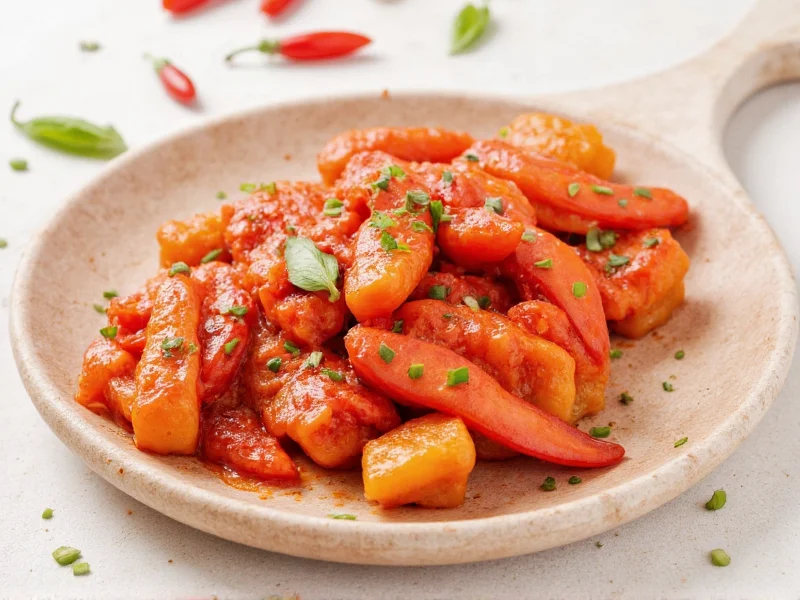Understanding Korean cooking ingredients is essential for authentic flavor development. Many home cooks face the dilemma of substituting gochugaru when only gochujang is available, or vice versa. This guide provides practical solutions based on culinary science and traditional Korean cooking principles.
Understanding Gochugaru and Gochujang Fundamentals
Gochugaru, Korea's vibrant red pepper flakes, delivers a unique combination of mild heat, subtle sweetness, and distinctive fruitiness. Unlike standard crushed red pepper, authentic gochugaru comes from sun-dried Korean chili peppers ground to a coarse, flaky consistency. Its flavor profile contains notes of berry and tobacco with moderate heat (around 1,500-2,000 Scoville units).
Gochujang presents a completely different culinary profile. This fermented red pepper paste combines gochugaru with glutinous rice, fermented soybeans (mejugaru), and sweeteners. The resulting product has a thick, sticky texture with complex umami, noticeable sweetness, and moderate heat. Its fermentation process creates deep, savory notes that develop over months.
Key Differences Between These Essential Korean Ingredients
| Characteristic | Gochugaru | Gochujang |
|---|---|---|
| Texture | Dry flakes/powder | Thick, sticky paste |
| Primary Ingredients | Korean chili peppers | Gochugaru, rice, fermented soybeans, sweeteners |
| Flavor Profile | Fruity, mildly sweet, moderate heat | Umami-rich, sweet, fermented, moderate heat |
| Moisture Content | Dry (0-5%) | High (40-50%) |
| Traditional Uses | Kimchi, soups, dry rubs | Stews, sauces, marinades |
When Substitution Works: Practical Applications
Substituting gochujang for gochugaru requires careful recipe adjustments. The most successful applications occur in liquid-based dishes where the paste can integrate smoothly. For gochugaru substitute gochujang conversions in stews like budae jjigae or sundubu jjigae, use this approach:
- Replace 1 tablespoon gochugaru with 1 tablespoon gochujang
- Reduce additional liquid by 1-2 tablespoons
- Omit any added sweeteners (sugar, honey)
- Add ½ teaspoon rice vinegar to balance sweetness
This gochujang to gochugaru conversion maintains the dish's intended heat level while compensating for the paste's moisture and sweetness. The substitution works because liquid-based recipes can accommodate the additional moisture from gochujang.
When Substitution Fails: Critical Limitations
Certain applications absolutely require gochugaru's dry texture. Attempting gochugaru substitute with gochujang in these scenarios produces unsatisfactory results:
- Kimchi preparation - Gochujang's moisture prevents proper fermentation and creates slimy texture
- Dry rubs for meats - Paste creates steamed rather than seared texture
- Seasoning for roasted vegetables - Causes burning rather than caramelization
- Finishing spice sprinkles - Impossible to achieve with liquid paste
For those wondering can I use gochujang instead of gochugaru in kimchi, the answer is no. Traditional kimchi requires gochugaru's specific drying properties to create the proper fermentation environment. Substituting gochujang creates excess moisture that promotes spoilage rather than fermentation.
Better Alternatives When Gochugaru Is Unavailable
When seeking a gochugaru alternative for Korean recipes, consider these options before reaching for gochujang:
- Smoked paprika + cayenne (2:1 ratio) - Provides similar color and mild heat
- Aleppo pepper flakes - Offers comparable fruitiness with moderate heat
- Guajillo chile powder - Delivers mild heat with berry notes
- Combination approach: 1 tsp paprika + ½ tsp cayenne + ¼ tsp garlic powder
These alternatives better mimic gochugaru's dry texture without introducing unwanted moisture or sweetness. For authentic Korean cooking ingredient substitutions, they provide more reliable results than attempting to use gochujang as a direct replacement.
Professional Tips for Successful Substitutions
When you must use gochujang instead of gochugaru, follow these chef-recommended techniques:
- Dry it out: Spread gochujang thinly on parchment paper and dehydrate at lowest oven setting until dry, then grind to powder
- Balancing act: For every tablespoon of gochujang substituted, add ¼ teaspoon rice vinegar to counter sweetness
- Layering technique: Add gochujang early in cooking to allow flavors to integrate properly
- Texture management: When substituting gochujang for gochugaru in soups, whisk thoroughly to prevent clumping
Understanding how to replace gochugaru with gochujang properly requires recognizing that you're not just replacing heat, but compensating for multiple ingredient properties. The successful cook adjusts not just for spice level but for moisture content, sweetness, and texture.
When to Seek Authentic Ingredients
While substitutions have their place, certain Korean dishes demand authentic ingredients. For traditional tteokbokki, bibimbap sauce, or kimchi, nothing replicates gochugaru's specific contribution. Specialty Asian markets and online retailers now make genuine gochugaru widely accessible. Investing in proper ingredients yields dramatically better results than struggling with imperfect substitutions.
Conclusion
Mastering Korean cooking ingredient substitutions requires understanding each component's role in the dish. While gochujang instead of gochugaru can work in specific liquid-based applications with proper adjustments, recognizing when substitution is inappropriate proves equally important. The most successful cooks maintain a well-stocked pantry with authentic ingredients while understanding practical alternatives for occasional substitutions. This balanced approach preserves culinary integrity while accommodating real-world cooking challenges.











 浙公网安备
33010002000092号
浙公网安备
33010002000092号 浙B2-20120091-4
浙B2-20120091-4